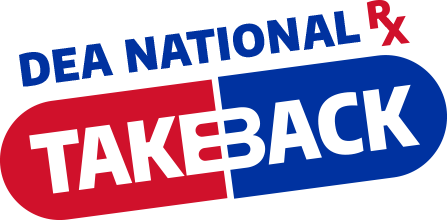Take Back Day
April 27, 2024
Collection Site Locator
DEA’s National Prescription Drug Take Back Initiative
The drug overdose epidemic in the United States is a clear and present public health, public safety, and national security threat. DEA’s National Prescription Drug Take Back Day reflects DEA’s commitment to Americans’ safety and health, encouraging the public to remove unneeded medications from their homes as a measure of preventing medication misuse and opioid addiction from ever starting.
Too often, unused prescription drugs find their way into the wrong hands. That’s dangerous and often tragic. That’s why it was great to see thousands of folks from across the country clean out their medicine cabinets and turn in – safely and anonymously – a record amount of prescription drugs.

National Take Back Day Results
-
- Total Law Enforcement Participation: 4383
- Total Collection Sites: 4675
- Total Weight Collected: 599,897 lbs. (300 tons)
- Total Weight All Time: 17,900,351 lbs. (8,950 tons)
-
- Total Law Enforcement Participation: 4,497
- Total Collection Sites: 4,955
- Total Weight Collected: 663,725 lbs. (332 Tons)
- Total Weight All Time: 17,300,454 lbs. (8,650 Tons)
-
- Total Law Enforcement Participation: 4,340
- Total Collection Sites: 4,902
- Total Weight Collected: 647,163 lbs. (324 Tons)
- Total Weight All Time: 16,636,729 lbs. (8,318 Tons)
Mental Health & Substance Use Treatment Locator
FindTreatment.gov is a confidential and anonymous resource for individuals seeking treatment for mental and substance use disorders in the United States and its territories.
SAMHSA Resource Locator
Click the link below and type in your address, city, zip code, or a facility name to locate the nearest treatment options.
SAMHSA Opioid Overdose Prevention Toolkit
Opioid Facts, Information for Prescribers, Safety Advice for Patients & Family, Recovering from Opioid OverdoseSave Lives with Naloxone
Naloxone is a medication used to reverse opioid overdose. It works by binding to the same receptors in the brain that opioids bind to, effectively displacing the opioids and reversing their effects. This can quickly restore normal breathing and consciousness to a person who has overdosed on opioids.
Learn more about reversing opioid overdoses with naloxone.
How is naloxone given?
Naloxone should be given to any person who shows signs of an opioid overdose or when an overdose is suspected. Naloxone can be given as a spray or it can be injected into the muscle, under the skin, or in the veins.
Who should carry naloxone?
If you or someone you know is at increased risk for opioid overdose, especially those struggling with opioid use disorder (OUD), you should carry naloxone and keep it at home. People who are taking high-dose opioid medications (greater or equal to 50 morphine milligram equivalents per day) prescribed by a doctor, people who use opioids and benzodiazepines together, and people who use illicit opioids like heroin should all carry naloxone. Because you can’t use naloxone on yourself, let others know you have it in case you experience an opioid overdose.